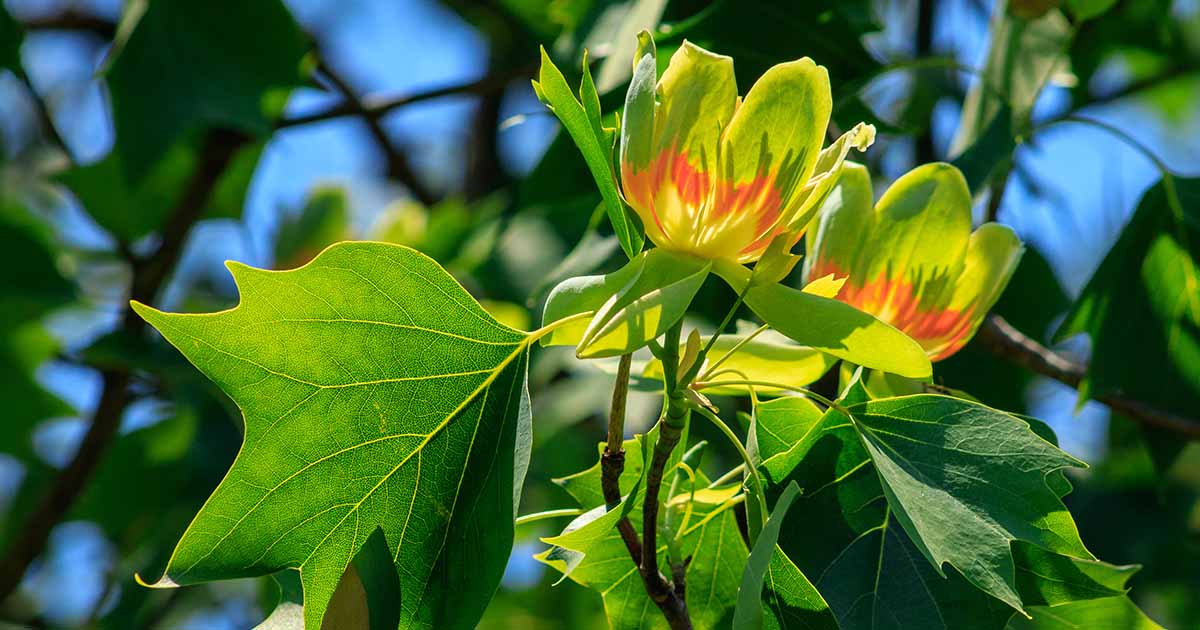Fortunately, there are several shorter statured cultivars to choose from in case you don’t have the space for such a giant.
Keep reading to learn how to grow this North American native in your backyard.
How to Grow
Although this species is a wonderful addition to mixed woodland, not all of us have the land to support so many trees.


Tulip tree makes a delightful specimen, somewhere out in the sunshine where it can grow to its behemoth height and dangle flower-laden branches.
The fall foliage is a dazzling yellow, and amazing to behold, too. Plant it somewhere you can easily see it year round.
Tulip tree is an easy to grow, unfussy choice that will thrive in a variety of settings.
Light
If possible, plant your tulip tree in full sun.
A little afternoon shade won’t hurt, but as L. tulipifera is known as a “pioneer” species, they are among the first to start turning open land back into forest, and to do this they need plenty of light.


Owing to their fast growth, this species is also fairly fragile. While full sun is important, keeping your tree out of locations exposed to high winds is critical too.
Big storms can really pummel a tulip tree, causing a huge mess of fallen branches and twigs.
Soil
This species prefers moist, freely-draining, loose soil that has a slightly acidic to neutral pH of 6.0 to 7.0.
If you live in an area with exceptionally sandy soils, L. tulipifera is unlikely to thrive.
Water
While your newly planted tulip trees are becoming established, make sure you provide water at least once a week in the absence of rain.


After about six months they should be relatively drought-tolerant.
Tulip trees have a very long taproot, but if summer is especially dry, and you can’t count on a shower at least once a week, make sure you continue to water it deeply.
I like to leave a hose on a trickle and place it at the base of my plant for a good couple of hours during dry spells.
Fertilizing
Some gardeners will suggest that you fertilize your tulip tree, but it’s not necessary.
These large, long lived, deep rooted trees will find the nutrients they need so long as they’re sited in an appropriate location.
Cultivars to Select
There are a few cultivars available but they can be somewhat hard to find. The main difference between cultivated varieties and the species plant is the height.


Tulip Tree
If you want to grow the species, you can find saplings available at Nature Hills Nursery.
Fast Growing Trees also carries the species in a variety of sizes.
If you can’t accommodate the mature size of the species in your own backyard there are a few, more compact cultivars to choose.
Arnold
‘Arnold’ is a narrow, upright cultivar growing to heights of 50 feet, and a width of 15 feet.
Emerald City
‘Emerald City’ has dark green leaves, bright yellow fall foliage, and tops out at about 55 feet high and 25 feet wide.
Little Volunteer
‘Little Volunteer’ features smaller leaves than the straight species, and grows to approximately 30 feet high and 20 feet wide.
Lucanthum
‘Lucanthum’ sports white blossoms, and grows as tall as the wild type species from which it is derived.
Propagation
L. tulipifera can be propagated from seed, stem cuttings, or by transplanting a sapling.
From Seed
If you live in an area within the native range of the tulip tree you can collect seed from a wild population.
You can collect the seed heads when they are light brown and come away from the plant easily. Throw away any seed with evidence of insect damage such as brown spots or little holes.


Store collected seed in a paper bag or envelope and keep in a cool, dark, well ventilated location until you’re ready to sow.
Like most temperate species, the seeds require a period of exposure to cold, known as cold stratification, before germination can take place.

